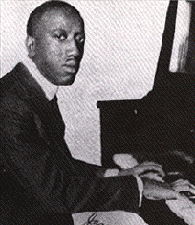The 1920s were a dynamic time in American history. Flappers tested the limits of fashion. Bootleg liquor fought prohibition. In music, the era became known as the Jazz Age. And James P. Johnson, a budding pianist, became one of the best-known musicians of the time.
James P. Johnson’s Early Days
James Price Johnson was born on February 1, 1894, in New Brunswick, New Jersey. During his early years, Johnson studied piano and learned to play classical and ragtime piano music. As an older teen, he provided music for parties, saloons and dance halls in Manhattan.
The more he played, the more he solidified his reputation as one of the best pianists on the East Coast. He developed a flair for adding “embellishments, variations, and improvisations” to songs, says Encyclopedia Britannica, forming a style all his own.
Johnson’s Music
In 1915, Johnson began making piano rolls, the mechanism that helps player pianos to produce music. A few years later, Johnson became an instructor to a great musician, Fats Waller, and started recording his music in earnest.
One of the highlights on Johnson’s musical resume is his title as the father of stride piano. Stride evolved from ragtime music and was fused with jazz and classical music. “Conventional ragtime had syncopation but lacked polyrhythm,” wrote DownBeat Magazine. “James P. developed a strong and solid walking bass with his left hand and a rhythmic exciting treble with his right. His music flowed at an even tempo with considerable syncopation between the two hands. He superimposed conflicting rhythms in solos of symmetrical beauty.”
Johnson’s showmanship abilities only added to the appeal of the music. Both “highbrow and lowbrow” audiences fell in love with it, and his “sound was heard all over Harlem,” explains the Kennedy Center.
Some of his signature songs include “Carolina Shout,” “Carolina Balmoral” and “Snowy Morning Blues.” One of his most popular works is “The Charleston,” a tune that became a hallmark of the Roaring Twenties.
Sources in this Story
- Encyclopedia Britannica: James P. Johnson
- DownBeat Magazine: James P. Johnson Dies, But Leaves Large Legacy
- The Kennedy Center: ArtsEdge: Drop Me Off in Harlem: James P. Johnson
- The Red Hot Jazz Archive: James Price Johnson
During his career, Johnson played as an accompanist for more than 400 recordings, and was a back up for popular blues singers like Ida Cox, Bessie Smith and Ethel Waters. According to the Red Hot Jazz Archive, his 1921 recording of “Carolina Shout” is considered by some to be the first-ever jazz piano solo to be recorded.
Rhapsody Online features recordings of many of Johnson’s songs.
The Rest of the Story
For all his musical ability, the racial prejudices of the day proved to be a hindrance to Johnson’s career. Broadway producers restricted him to performing in all-black shows, which did not appeal to white audiences. In an obituary for DownBeat Magazine, famed record producer John Hammond wrote that Johnson was “always hoping that the white world would recognize his talents. It never did.”
Despite the restrictions placed on him, Johnson was still interested in composing longer musical pieces. He wrote scores for symphonies, operettas, chamber music and piano sonatas. During the 1930s, he created works like “Harlem Symphony” and “Symphony in Brown.” Much of his music, however, has been lost over the years.
In the 1940s, Johnson had a series of strokes, but he remained active in music until a major stroke ended his music career in 1951. He died on November 17, 1955, in Jamaica, New York.
This article was originally written by Lindsey Chapman; it was updated January 12, 2017.











